
© Railway Wonders of the World 2012-


South African Electrification
Progress of Big Power Schemes
RAILWAYS OF THE COMMONWEALTH -
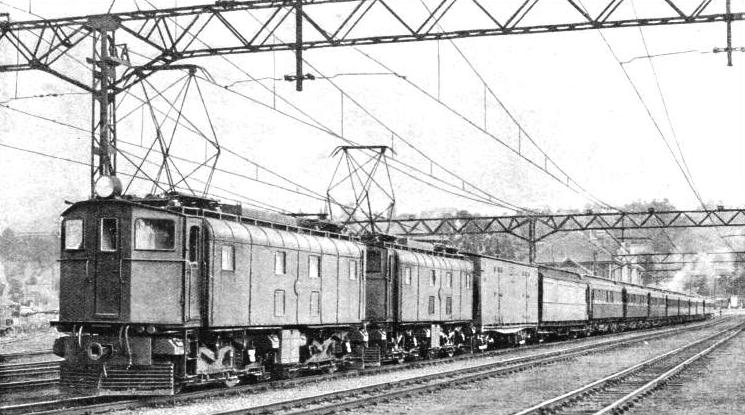
PASSENGER AND MAIL TRAIN on an electrified section of the railway in Natal. Electrification of sections of the South African Railways was begun in 1923, the first stretch to be converted being 171 route miles in Natal, between Glencoe and Pietermaritzburg.
THE Natal section of the South African Railways and Harbour Administration constitutes the longest electrified main-
The Glencoe-
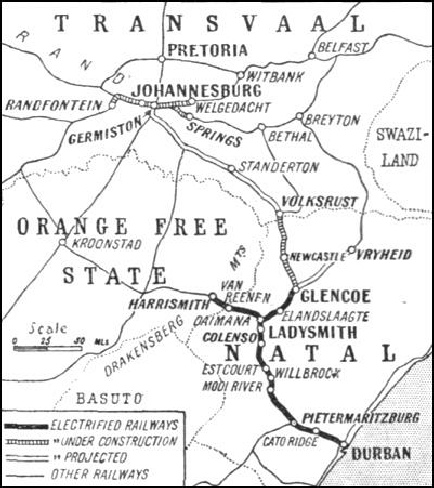
THROUGH RUNNING with electric trains is planned between Durban and Johannesburg, a distance of some 485 miles. This map shows the position of electrification at the present time.
The extension of electrification from Glencoe to the Transvaal frontier has an added importance in view of the recently announced decision to convert 223 track miles of railway in the neighbourhood of Johannesburg to electrical operation. This scheme, for which £1,000,000 have already been voted, and on which work has already begun, includes the line running roughly west to east from Randfontein via Johannesbuig and Germiston to Springs, and the line from Germiston to Welgedacht. These seventy-
Electrical operation on the Natal railway from Glencoe to Pietermantzburg was put in hand in 1923. It is not until the gradients between these towns are studied that it is realized, first, why electric traction had to be adopted on the Natal Railway (which has a relatively low traffic density), and secondly, why work began from north to south and not from Durban, the outlet of Natal, northwards.
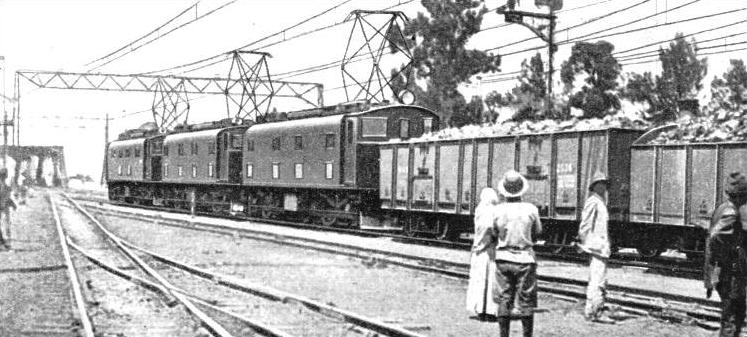
THREE 3,000 VOLT LOCOMOTIVES, each of 1,200 hp. All classes of electric trains on the Natal Railway, whether freight or passenger, are hauled by 1,200 hp units. The locomotives are arranged for use in multiple, and are fitted with couplings strong enough to make possible the operation of four locomotives from one cab.
Glencoe is the centre of the Natal coalfields, and a large proportion of the traffic south to Durban is coal for export (ship coal in large part), The fact that it pays to bring this coal 240 miles to Durban is due partly to the fact that the coal mining is surface mining, and partly to the cheap railway rates and efficient service. The railway has a hard task to perform.
Glencoe is 4,310 ft above sea-
From Colenso to Estcourt, a distance of about twenty miles, the line rises again to 3,830 ft, and thence to a summit-
The average speed of steam traction here was 8 mph; that of electric locomotive trains is 21 mph, with slightly higher speeds in anticipation. The railway route from Glencoe to Pietermaritzburg is 171 miles; as the crow flies the distance is only 100 miles. The sharpest curve on the line is of 300 ft radius, and there are many curves of 573 and 716 ft. About one quarter of the track mileage has a radius of 1,100 ft or less.
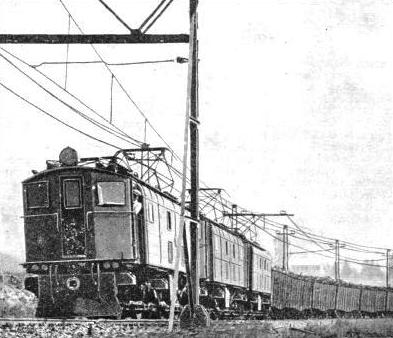
HAULING A HEAVY COAL TRAIN up a 1 in 65 gradient on the Natal Railway. Between Glencoe and Pietermaritzburg freight trains of 1,500 tons hauled by three electric locomotives coupled together -
It is interesting to examine the results of electrification on this section. Before electrification the maximum tonnage moved south of Ladysmith, making the fullest possible use of steam traction, was 25,351 tons. The General Manager’s report tor 1926 stated that the ninety-
The saving in wage-
There are two routes between Pietermaritzburg and Durban, of which the newer, with its 1 in 66 gradients, as compared with 1 in 33 to the north, has been chosen for electrification. The work of electrification between Cato Ridge and Durban has necessitated the doubling of the track, and the laying of the second track -
The Glencoe-
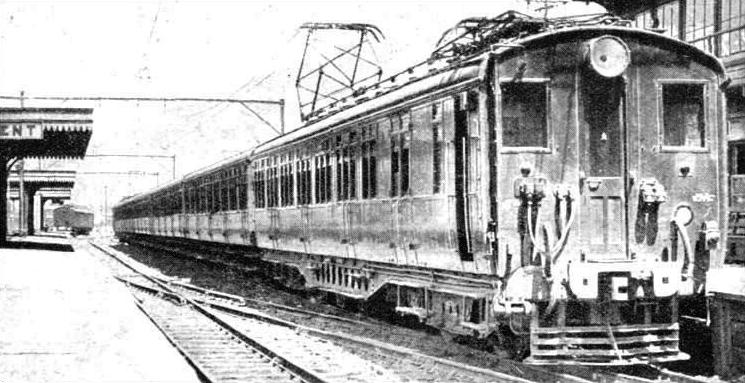
MONUMENT STATION, at Cape Town, on the electrified suburban lines. The scheduled average speed of the suburban trains is twenty-
There are two other stretches of railway which are of obvious importance -
The locomotives used on this Natal line are of particular interest. All classes of service, whether freight or passenger, are hauled by 1,200 horsepower locomotive units. These units are arranged for use in multiple, and are fitted with couplings of sufficient strength to allow four locomotives, if necessary, to be operated in multiple from a single cab.
The main power equipment of each locomotive unit consists of four traction motors designed to work at 1,500 volts and coupled, two in series, across the 3,000-
The body of the locomotive is divided into five compartments consisting of a driving cab at either end, two auxiliary machinery compartments adjoining these, and a high-
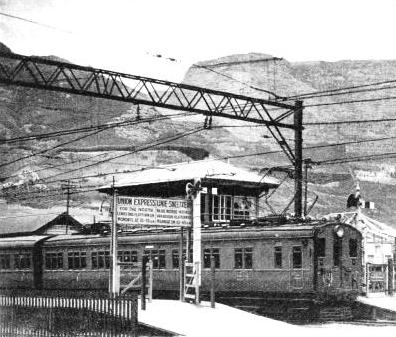
ON THE CAPE TOWN SUBURBAN LINE, a train at Monument Station. Electrical operation of trains from Cape Town to Seapoint began in 1927, and from Cape Town to Simonstown in 1928. Overhead electrification at 1,500 volts DC was adopted. In the background of the illustration is seen part of the world-
The machinery compartments between the central high-
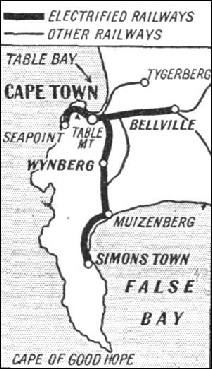 The Natal electrification is claimed to be the first in which regeneration was used extensively with coupled locomotives. The system has proved completely satisfactory. The main object of regeneration on the Natal Railway is not so much the saving of coal which may be effected, as to enable a higher speed to be attained on down grades. The ordinary braking system can thus be held in reserve.
The Natal electrification is claimed to be the first in which regeneration was used extensively with coupled locomotives. The system has proved completely satisfactory. The main object of regeneration on the Natal Railway is not so much the saving of coal which may be effected, as to enable a higher speed to be attained on down grades. The ordinary braking system can thus be held in reserve.
THE ROUTES of the electrified lines around Cape Town. Power for the suburban lines is derived from a specially constructed power station at Salt River, two miles east of Cape Town.
In addition to this long and important main line electrification, the South African Railways and Harbour Administration operate electrically the Cape Town Suburban Railways. The transport problem of Cape Town is, for geographical reasons, a peculiar one. Cape Town itself is built on a comparatively small area between Table Bay and the almost vertical face of Table Mountain. Outside the city site, building has been still further limited by the rocky nature of the district, so that the suburbs of Cape Town, with their daily travelling population, are restricted to a narrow strip of country along the side of the mountain between Cape Town and Wynberg, and to the area between False Bay and the mountain extending from Muizenberg to Simonstown. This area lies between fifteen and a half and twenty-
Overhead electrification at 1,500 volts DC was adopted, and power is taken from a specially built power station.
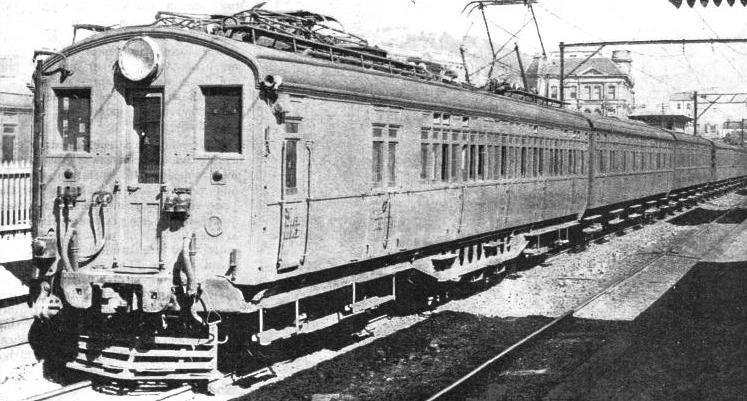
LOCAL TRAIN on the Seapoint route of the Cape Town electrified suburban lines. Motor coaches on this railway are equipped with four motors with a one-
You can read more on “The Cape Town to Johannesburg Express”, “Developments in South Africa” and “Electrification Overseas” on this website.